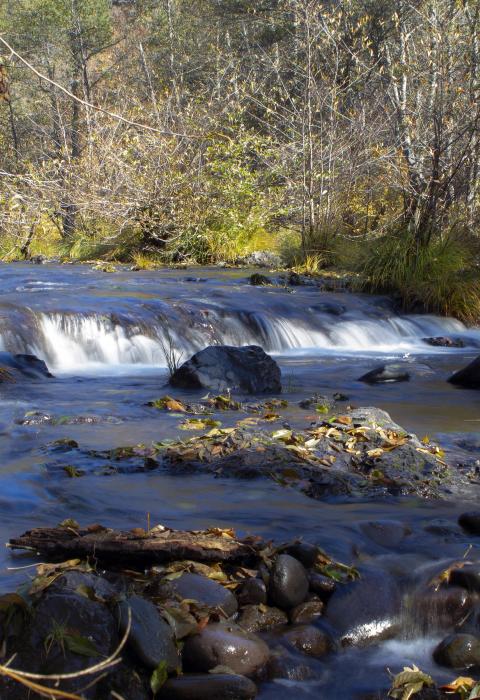Elk Creek
Oregon
Elk Creek is a key tributary of the Rogue River located near the southwestern Oregon community of Shady Cove, about 25 northeast of Medford. It flows approximately 18 miles from its headwaters to its confluence with the Rogue, just below the U.S. Army Corps of Engineers’ Lost Creek Dam.
Originating from the mountains of the high Cascades Mountain ecoregion, the forests, riparian, and meadow landscapes of this watershed are uniquely diverse. Influenced by a multiple-use patchwork of mixed federal and private land ownership, the Elk Creek Basin remains rich in fish and wildlife habitat values. Family friendly outdoor recreation opportunities include easy access to the gentle, old road grade that parallels the creek. Converted to a day-use path, the meandering trail is accessible throughout the year and is regularly enjoyed by sightseers, bicyclists, hikers, and runners of all abilities. Several deep swimming holes are attractive during the hot summer months, and the sights and sounds of the free-flowing creek provide a shady respite for all who visit this unique addition to the National System of Wild and Scenic Rivers System.
The recent management history of Elk Creek is a long and winding road, which began with the development and partial construction of the Elk Creek Dam. One of three major dams comprising the Rogue Basin Project, project development was initiated 1971, and dam construction began in 1986. Contentious from the beginning, and following nearly 25 years of litigation, the dam was finally notched in 2008. Although significant restoration work remains at the de-authorized dam site, native fish can now find their way once again in the free-flowing waters of Elk Creek and its tributaries.
Due to the presence and impact of the dam, Bureau of Land Management (BLM) administrative studies during the 1990's determined that Elk Creek was ineligible for wild and scenic river designation, although it was noted that fish and wildlife were potential outstandingly remarkable values (ORVs). Despite the BLM findings, in 2019, the John D. Dingell Jr. Conservation, Management and Recreation Act designated 7.3 miles of the creek to be managed as a wild and scenic river by the U.S. Department of Interior, although much of the land area of the designated river continues to be administered by the Portland District of the U.S. Army Corps of Engineers. Following designation, the Congressional Record identified ORVs as fish (wild coho, spring and fall chinook, and wild summer and winter steelhead) and wildlife (Roosevelt elk winter range).
With the assistance from federal and other local partners, instream, riparian, and upland restoration efforts continue to help protect and enhance this designated river for present and future generations.
Designated Reach
March 12, 2019. From its confluence with Flat Creek to the southern edge of the Army Corps of Engineers boundary in T 33 S, R 1 E, Section 30, Willamette Meridian, near river mile 1.7.
Outstandingly Remarkable Values
Preliminary Finding
Fish
Elk Creek provides critical spawning and rearing habitat for a variety of anadromous and resident species of fish, including fall and spring chinook, coho, winter and spring steelhead, and Pacific lamprey. Cutthroat and rainbow trout have been found throughout the creek and all the major tributaries. Dozens of these tributaries provide the cool water and critical spawning habitat that enhance the dwindling native fish populations of the Rogue Basin. Fish returns have vastly improved since the dam was breached, and Elk Creek remains critical habitat in support of the important fisheries of the Rogue River.
Preliminary Finding
Wildlife
Like the terrain, vegetation and climatic influences that characterize southwestern Oregon, the terrestrial wildlife habitats of the Elk Creek Basin are extremely diverse. About one-third of the lower Elk Creek watershed provides important big game winter range habitat. A resident population of Roosevelt elk resides in the area. The basin also provides critical habitat for the imperiled northern spotted owl, listed as threatened under the Endangered Species Act. The watershed is also home to several BLM sensitive species, such as the bald eagle, western pond turtle, yellow-legged frog, monarch butterfly, and western bumblebee. In addition, beaver can be found occupying and naturally modifying the riparian and aquatic habitats of Elk Creek.

